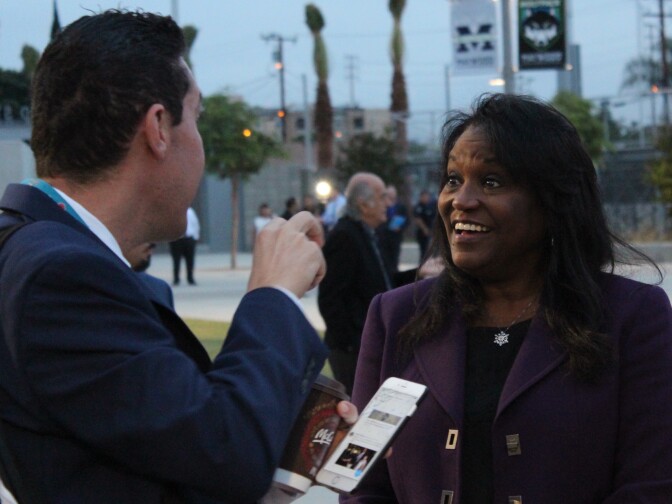This story is free to read because readers choose to support LAist. If you find value in independent local reporting, make a donation to power our newsroom today.
This archival content was originally written for and published on KPCC.org. Keep in mind that links and images may no longer work — and references may be outdated.
LA Unified's most drastic measures to combat school overcrowding are now officially history
Tuesday wasn't only the beginning of a new academic year in the Los Angeles Unified School District. It also marked the end of an era.
In 1997, in the face of massive overcrowding in its school buildings, L.A. Unified leaders and voters launched what would become perhaps the largest new school construction project in the nation's history, a project that would ultimately create new, permanent space for more than 170,000 students.
On Tuesday morning, the last new school built as part of that project — the Maywood Center for Enriched Studies, or "MaCES" for short — opened its doors to students for the first time. District officials gathered at the school early Tuesday to celebrate the occasion.
District officials say Maywood school's opening will help alleviate overcrowding at nearby Bell High School — the last campus to operate on the year-round calendar that was once a necessity for more than 200 L.A. Unified schools to accommodate massive numbers of students.
But now that MaCES is open, Bell can operate on a normal calendar this year. Thousands of L.A. Unified students remain in portable classrooms — but at least two of the district's most drastic anti-overcrowding measures of the recent past are now officially history.
"The Maywood Center for Enriched Studies," L.A. Unified School Board president Ref Rodriguez said, "is going to do two phenomenal things, historic things: end forced busing in LAUSD and end year-round in LAUSD. We're really proud of that."
To Mark Slavkin, who served on the L.A. Unified board from 1989 to 1997, the change feels like "a whole other world."

"As of now," Slavkin said, "there are no year-round calendars — that seemed so impossible back then."
Between 1980 and 2000, L.A. Unified's enrollment rose from 550,000 students to around 750,000 kids, according to Mark Hovatter, the district's chief facilities officer.
The surge created a capacity crisis. In some instances, neighborhood elementary, middle or high schools were over-enrolled by hundreds, if not thousands of students, Slavkin said.
"It’s hard to over-dramatize the magnitude of all those challenges," Slavkin remembered.
District officials were forced not only to adopt year-round calendars, but in many cases to forcibly bus students across town to schools with available space.
Essentially, Slavkin said, kids were told, "There is no school here [in your neighborhood] for you. You’re going to get on the bus here when it’s dark out in the morning and take an hour-long bus ride to west L.A. or the Valley to a community very foreign and very far from your parents, and then come back late in the afternoon, in traffic."
Near the end of Slavkin's tenure, the board decided to propose a property tax increase to fund new school construction that would alleviate the crisis. He voted to put a bond measure on the November 1996 ballot; it failed.
But in 1997, Slavkin and a majority of the board voted to try again on the April city-wide ballot. That $2.4 billion bond measure passed. Succeeding school boards and district leaders (notable among them: former district superintendent Roy Romer) pushed and won voter approval for another four property tax increases in 2002, 2004, 2005 and, most notably, for $7 billion in 2008.
"If you took all the new seats that we've created," Hovatter said, "and broke that off and it became another school district, it would be very close to the largest school district in the state other than L.A. Unified."
The irony, though, is that the building spree meant to accommodate massive overcrowding in L.A. Unified has come to an end during a period of precipitous enrollment decline in the district. District leaders initially envisioned needing to raise around 160 new schools instead of the 131 they've built.
School board president Ref Rodriguez has spoken of the need for L.A. Unified to "elegantly contract," which he has said means finding ways to trim services or programs in proportion to the district's enrollment decline — without necessarily shuttering buildings.
"Over time, we have to shrink to the right size," Rodriguez said, "and ensure that the core academic programs and the core components of the school stay intact so that kids are able to achieve."
Slavkin noted the challenges L.A. Unified has faced since he left office, from political scandals to budget cuts. But Slavkin pointed out voters could see those challenges — including declining enrollment — and yet approved many of the tax increases that funded L.A. Unified's building program.
"The fact," Slavkin said, "that within that climate, voters — and many of whom don’t have kids in schools — would time after time after time, vote to tax themselves [to build schools] … is kind of remarkable and speaks to a story that’s not told that maybe there is this degree of …support ultimately for the institution that we tend not to believe is ever there."









